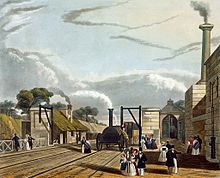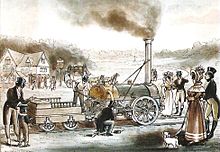Parkside Railroad Accident
In the railway accident at Parkside was during the opening Liverpool and Manchester Railway , MP of the September 15, 1830 Liverpool and former colonial, war and trade ministers of Britain , William Huskisson run over. He died of the consequences of the accident. This was the first railway accident in which a passenger was fatally injured.
Starting position
politics
The Prime Minister , Duke of Wellington , very conservative, weakened politically - he was threatened with an early replacement. Not only did the opposition attack him, but also the liberal wing of his own party, the Tories . The liberal wing also included William Huskisson, a proponent of the initially controversial project of a railway between Liverpool and Manchester . Huskisson had initially belonged to the government of Wellington, but then overwhelmed the Prime Minister with his demands for reforms and was dismissed by him in May 1828. Huskisson was now "only" a member of Parliament for Liverpool, a career setback for him. He and Wellington had hardly spoken to each other since his release.
Infrastructure
The route of the Liverpool and Manchester Railway was double-tracked throughout - one track for each direction of travel. The distance between the two tracks was four feet (about 1.25 m). There were a number of stations along the route that also served to allow locomotives to pick up water along the way.
vehicles

The early locomotives had no brakes . There were only brakes on some of the cars . In the train set , the brakes were mainly used to brake the wagons. If a locomotive drove alone, it could only brake if the engine driver changed direction and let the machine work against the direction of travel. It took about 10 seconds for such a "braking" to take effect and the locomotive to slow down. A lot of experience was also required to bring a locomotive to a stop like this.
The inaugural train in which the Duke of Wellington rode consisted of the Northumbrian locomotive and four open passenger cars , including a particularly beautifully designed saloon car for the Duke of Wellington . However, the car had no permanently installed entry steps. Rather, a small ladder that was carried in one of the other cars had to be placed under the respective door so that passengers could comfortably get on or off. There was also another splendidly decorated car in front of and behind. The VIPs from politics and society and the directors of the railway were housed in these cars . There were seats on the long sides of the wagons and a bench in the middle, which was arranged in the direction of travel. Between these three cars and the locomotive, there was another car with a band on it . The doors of all the cars opened outwards. The engine driver of this train was George Stephenson .
Opening operation
All trains at the opening were to travel together from Liverpool to Manchester in the morning and then back again in the afternoon. On the occasion of the opening, there was a special operating situation: the southern of the two main tracks was reserved for the Duke of Wellington's special train . Its special train should have the opportunity to stop anywhere to view special features and keep the pace that the Prime Minister wanted. The seven remaining trains for the "normal" passengers, passengers who had managed to get a ticket for one of the reserved seats, drove as a convoy one behind the other on the northern track within sight. When the Duke of Wellington's train drove a little slower, some of the convoy's trains passed the Duke's train on the second platform, which later overtook them. The third of these inaugural trains in the convoy on the northern track was pulled by the Rocket . Your engine driver was Joseph Locke .
The Duke of Wellington appeared at Liverpool train station about half an hour late to board his special train. Huskisson and his wife, Emily, had been assigned seats in the car that ran in front of the Prime Minister's car on his train. The Prime Minister's special train ran smoothly to Parkside Station . There was a scheduled stop here at 11:55 a.m. so that the locomotives could refill water. The passengers had been asked not to leave the trains.
the accident
Nonetheless, about 50 men got off the Prime Minister's train to stretch their feet while the water in the Northumbrian was replenished. William Huskisson also got out of his car. Two trains on the parallel track passed the Prime Minister's train. Huskisson wanted to take the opportunity to go to the Prime Minister and greet him. So he wanted to use the joyful elation of the opening to relax their mutual relationship again. Huskisson crossed the parallel track and went to the prime minister's car, who was sitting in the front corner, and the men shook hands. At that moment the third train approached on the parallel track with the Rocket at the head. Those standing in the track area got back on the train or took the embankment on the other side of the northern track. Getting into the Prime Minister's car proved difficult because the boarding ladder was not ajar. Some were dragged in by their hands and clothes by fellow travelers. Everyone managed to evade, except for one fellow passenger and Huskisson, who apparently panicked . After two unsuccessful attempts to cross the parallel track and to get to safety on the other side, he tried to get into the duke's car. Joseph Locke had noticed him by now and countered to bring the Rocket to a halt. There was a space of around 60 cm between the two vehicles, which in the case of his fellow passenger was sufficient to prevent the accident. Huskisson tried to climb the car, but got hold of a door, which, however, could not withstand his weight, swung open, and so carried him directly into the clearance profile of the Rocket . The Rocket hit the door, Huskisson fell between its wheels and the locomotive partially ran over his leg, which was not severed but seriously injured.
consequences
The injured Huskisson was laid on a door leaf for a transport that was hung up in one of the station buildings. On the Prime Minister's train, the coupling between the first car (on which the musicians had sat) and the car for the guests of honor was released and Huskisson and the door were laid on this first car. Since the doctors were unsure whether Huskisson would survive a trip to Manchester, it was decided to take him to the rectory at Eccles , which was near the railway line. The Northumbrian drove there as quickly as possible in one car, Huskisson and the people accompanying him, especially his wife and several doctors who were among the guests of honor. The Northumbrian reached a speed of 35 mph (56 km / h) - a world record . Huskisson was taken to the rectory. Doctors advocated amputation of his leg, but thought he was too weak to survive the shock of an operation alive. He died around 9 p.m. The jury , which met under a coroner the next day, came to the unanimous conclusion that it was an accident that could not be attributed to those responsible for the railway. That saved the Rocket from being declared a deodorant .
Worth knowing
William Huskisson was the first celebrity and passenger to be killed in a railroad accident. In literature he is often mentioned as the first person to be killed in a railroad accident. But that is not the case. Engineers, craftsmen and the curious have died before. The first non-railroader to be run over by a train had an accident in 1821.
A memorial to William Huskisson was erected in 1913 at the site of the accident - the Parkside train station has long been gone. This is parallel to the railway line, can only be seen from the passing train and therefore difficult to see.
See also
literature
- Frank Ferneyhough: Liverpool and Manchester Railway, 1830-1980 . Robert Hale Ltd, London 1980, ISBN 0-7091-8137-X .
- Simon Garfield: The Last Journey of William Huskisson . Faber and Faber, 2002, ISBN 0-571-21048-1 .
- John Andrew Hamilton: Huskisson, William . In: Sidney Lee (Ed.): Dictionary of National Biography . Volume 28: Howard - Inglethorpe. , MacMillan & Co, Smith, Elder & Co., New York City / London 1891, pp. 323 - 328 (English).
- Huskisson, William . In: Encyclopædia Britannica . 11th edition. tape 14 : Husband - Italic . London 1911, p. 4 (English, full text [ Wikisource ]).
- AC Howe: Huskisson, William (1770-1830). In: Henry Colin Gray Matthew, Brian Harrison (Eds.): Oxford Dictionary of National Biography , from the earliest times to the year 2000 (ODNB). Oxford University Press, Oxford 2004, ISBN 0-19-861411-X , ( oxforddnb.com license required ), as of January 2008
Web links
Remarks
- ↑ Two other opening trains in the convoy on the north platform had a rear-end collision (Garfield, p. 147).
- ↑ See for example: Brunton's Mechanical Traveler .
Individual evidence
- ↑ Garfield, pp. 35, 131, 156.
- ↑ Garfield, p. 31.
- ^ Garfield, p. 156.
- ↑ Garfield, p. 36.
- ↑ Garfield, p. 35.
- ^ Garfield, p. 143.
- ↑ Garfield, pp. 31, 35.
- ↑ Garfield, p. 142.
- ^ Garfield, p. 151.
- ^ Garfield, p. 151.
- ^ Garfield, p. 152.
- ^ Garfield, p. 155.
- ^ Garfield, p. 156.
- ^ Garfield, p. 161.
- ↑ Garfield, p. 163 ff.
- ^ Garfield, p. 171.
- ^ Garfield, p. 174.
- ^ Richard Balkwill, John Marshall: The Guinness Book of Railway Facts and Feats . 6th edition. (1993), ISBN 0-85112-707-X : On December 5, 1821, carpenter David Brook ran along the Middleton Railway in heavy sleek weather . He overlooked a train and was fatally injured.




